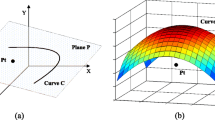Abstract
The objective of this article is to develop an anomaly detector as an analytical expression for detecting anomalous objects in remote sensing using hyperspectral imaging. Conventional anomaly detectors based on the subspace model have a parameter which is the dimension of the clutter subspace. The range of possible values for this parameter is typically large, resulting in a large number of images of detector output to be analyzed. An anomaly detector with a different parameter is proposed. The pixel of known random variables from a data cube is modeled as a linear transformation of a set of unknown random variables from the clutter subspace plus an error of unknown random variables in which the transformation matrix of constants is also unknown. The dimension of the clutter subspace for each spectral component of the pixel can vary, hence some elements in the transformation matrix are constrained to be zeros. The anomaly detector is the Mahalanobis distance of the resulting residual. The experimental results which are obtained by implementing the anomaly detector as a global anomaly detector in unsupervised mode with background statistics computed from hyperspectral data cubes with wavelengths in the visible and near-infrared range show that the parameter in the anomaly detector has a significantly reduced number of possible values in comparison with conventional anomaly detectors.



































Similar content being viewed by others
References
Schaum AP (2007) Hyperspectral anomaly detection beyond RX. In: Proceeding of 13th SPIE conference on algorithms and technologies for multispectral, hyperspectral, and ultraspectral imagery, vol 6565, p 656502
Stein DWJ, Beaven SG, Hoff LE, Winter EM, Schaum AP, Stocker AD (2000) Anomaly detection from hyperspectral imagery. IEEE signal processing magazine, pp 58–69
Schaum AP (2006) Hyperspectral detection algorithms: from old ideas to operational concepts to next generation. In: Proceeding of 12th SPIE conference on algorithms and technologies for multispectral, hyperspectral, and ultraspectral imagery, vol 6233, p 623305
Horwitz HM, Nalepka RF, Hyde PD, Morgenstern JP (1971) Estimating the proportions of objects within a single resolution element of a multispectral sensor. In: Proceeding of 7th international symposium on remote sensing of environment, Ann Arbor, pp 1307–1320
Stocker A, Schaum A (1997) Application of stochastic mixing models to hyperspectral detection problems. In: Proceeding of 3rd SPIE conference on algorithms and technologies for multispectral, hyperspectral, and ultraspectral imagery, vol 3071, pp 47–60
Stein (2003) Material identification and classification in hyperspectral imagery using the normal mixture model. In: Proceeding of 9th SPIE conference on algorithms and technologies for multispectral, hyperspectral, and ultraspectral imagery, vol 5093, pp 559–568
Grossman JM, Bowles J, Haas D, Antoniades JA, Grunes MR, Palmadesso P, Gillis D, Tsang KY, Baumback M, Daniel M, Fisher J, Triandaf T (1998) Hyperspectral analysis and target detection system for the adaptive spectral reconnaissance program (ASRP). In: Proceeding of 4th SPIE conference on algorithms and technologies for multispectral, hyperspectral, and ultraspectral imagery, vol 3372, pp 2–13
Duran O, Petrou M (2009) Spectral unmixing with negative and superunity abundances for subpixel anomaly detection. IEEE Trans Geosci Remote Sens Lett 6(1):152–156
Kwon H, Nasrabadi NM (2005) Kernel RX: a new nonlinear anomaly detector. In: Proceeding of 11th SPIE conference on algorithms and technologies for multispectral, hyperspectral, and ultraspectral imagery, vol 5806, p 35
Scholkopf B, Smola A, Muller KR (1998) Nonlinear component analysis as a kernel eigenvalue problem. Neural Comput 10(5):1299–1319
Lo E, Ingram J (2008) Hyperspectral anomaly detection based on minimum generalized variance method. In: Proceeding of 14th SPIE conference on algorithms and technologies for multispectral, hyperspectral, and ultraspectral imagery, vol 6966, p 696603
Rousseeuw PJ, Driessen KV (1999) A fast algorithm for the minimum covariance determinant estimator. Technometrics 41(3):212–223
Barnett V, Lewis T (1998) Outliers in statistical data, 3rd edn. Wiley, New York
Bernhardt M, Heather J, Watkins O (2006) Hyperspectral clutter statistics, generative models, and anomaly detection. In: Proceeding of 12th SPIE conference on algorithms and technologies for multispectral, hyperspectral, and ultraspectral imagery, vol 6233, p 623321
Juan J, Prieto FJ (2001) Using angles to identify concentrated multivariate outliers. Technometrics 43(3):311–322
Reed IS, Yu X (1990) Adaptive multiple-band CFAR detection of an optical pattern with unknown spectral distribution. IEEE Trans Acoustics Speech Signal Process 38(10):1760–1770
Schaum A, Stocker A (2002) Joint hyperspectral subspace detection derived from a Bayesian likelihood ratio test. In: Proceeding of 8th SPIE conference on algorithms and technologies for multispectral, hyperspectral, and ultraspectral imagery, vol 4725, pp 225–233
Chang C, Chiang S (2002) Anomaly detection and classification for hyperspectral imagery. IEEE Trans Geosci Remote Sens 40:1314–1325
Fowler J, Du Q (2011) Anomaly detection and reconstruction from random projections. IEEE Trans Geosci Remote Sens 21(1):184–195
Du B, Zhang L (2010) Random selection based anomaly detector for hyperspectral imagery. IEEE Trans Geosci Remote Sens 49(5):1578–1589
Lo E (2011) Maximized subspace model for hyperspectral anomaly detection. Pattern Anal Appl 20 March 2011 (published online first)
Lo E (2011) Variable subspace model for hyperspectral anomaly detection. Pattern Anal Appl 20 March, 2011 (published online first)
Lo E, Ingram J (2011) Algorithm for detecting anomaly in hyperspectral imagery using factor analysis. In: Proceeding of 17th SPIE conference on algorithms and technologies for multispectral, hyperspectral, and ultraspectral imagery, vol 8048, p 804805
Lo E (2010) Hyperspectral anomaly detector based on variable number of predictors. In: Proceeding of the 12th IASTED international conference on signal and image processing
Lo E, Schaum A (2009) A hyperspectral anomaly detector based on partialing out a clutter subspace. In: Proceeding of 15th SPIE conference on algorithms and technologies for multispectral, hyperspectral, and ultraspectral imagery, vol 7334, p 733404
Luenberger DG (1984) Linear and nonlinear programming, 2nd edn. Addison-Wesley, Reading
Fletcher R (1987) Practical methods of optimization, 2nd edn. Wiley, New York
Kerekes JP, Snyder DK (2010) Unresolved target detection blind test project overview. In: Proceeding of 16th SPIE conference on algorithms and technologies for multispectral, hyperspectral, and ultraspectral imagery, vol 7695, p 769521
Acknowledgments
The author wishes to thank the US Naval Research Laboratory in Washington DC for funding and data and the Center for Imaging Science at Rochester Institute of Technology for data.
Author information
Authors and Affiliations
Corresponding author
Rights and permissions
About this article
Cite this article
Lo, E. Variable factorization model based on numerical optimization for hyperspectral anomaly detection. Pattern Anal Applic 17, 291–310 (2014). https://doi.org/10.1007/s10044-012-0275-9
Received:
Accepted:
Published:
Issue Date:
DOI: https://doi.org/10.1007/s10044-012-0275-9




